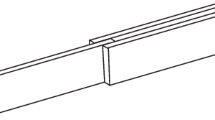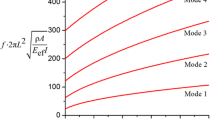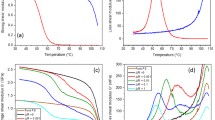Abstract
In this work it is theoretically shown that thermoelastic incompatibility between Silicon structures and their native-oxide layers induces thermoelastic damping. This damping dominates in structures that are packaged in vacuum and vibrate in pure axial motion. Analytic solutions of the thermoelastic response of axially loaded laminated bars are used to determine the material parameters which affect thermoelastic damping. The analysis suggests that thin shield-layers can significantly reduce thermoelastic damping which is associated with native-oxide layers in Silicon resonators.










Similar content being viewed by others
Abbreviations
- A in :
-
eigenfunction amplitude
- a :
-
bar thickness
- B in :
-
eigenfunction amplitude
- b 1, b 2 :
-
constants
- C i :
-
specific heat
- D :
-
stored elastic energy density per unit volume
- ΔD :
-
mechanical energy dissipated per unit volume
- E i :
-
Young’s modulus
- \( \tilde G\left( {\gamma _{n} } \right) \) :
-
normalized variable
- g i :
-
heat generation
- \( \tilde H_{n} \) :
-
normalized variable
- h :
-
thin layer thickness
- i :
-
layer index
- In:
-
Indium
- K :
-
dimensionless ratio of the thermal conductivity
- k i :
-
thermal conductivity
- \( \tilde N\left( {\gamma _{n} } \right) \) :
-
normalized variable
- n :
-
series index
- Q :
-
quality factor
- \( \tilde R_{n} \) :
-
normalized variable
- r α :
-
dimensionless ratio of the thermal diffusivity
- SiO2 :
-
Silicon native-oxide
- SCS:
-
Single crystal Silicon
- s P :
-
entropy produced per unit volume
- T i :
-
temperature
- \( \tilde T_{i} \) :
-
normalized temperature
- T 0 :
-
ambient temperature
- t :
-
time
- \( \tilde t \) :
-
normalized time
- Z i :
-
Zener coefficient
- z :
-
vertical coordinate
- \( \tilde z \) :
-
normalized vertical coordinate
- ε xx :
-
time-harmonic uniaxial strain
- ε 0 :
-
strain amplitude
- \( \sigma _{{kk}}^{i} \) :
-
hydrostatic stress
- ω :
-
harmonic frequency of the strain
- α i :
-
thermal expansion coefficient
- \( \alpha _{i}^{*} \) :
-
thermal diffusivity
- ρ i :
-
density
- β n :
-
eigenvalues
- γ n :
-
normalized eigenvalue
- δ :
-
thicknesses ratio
- Ω2 :
-
normalized frequency
- ϕ in :
-
eigenfunctions
- χ :
-
normalized parameter
- ψ :
-
volume-averaged specific damping capacity
- ψ L :
-
local specific damping capacity
- ψ c :
-
converged value of damping
- ψ 0 :
-
normalized parameter
References
Ashby MF (1999) Materials selection in mechanical design. Butterworth-Heinemann, Oxford
Bejan A (1988) Advanced engineering thermodynamics. Wiley, New York
Bishop JE, Kinra VK (1993) Thermoelastic damping of a laminated beam in flexure and extension. J Reinf Plast Compos 12:210–226. doi:10.1177/073168449301200207
Cahill DG, Ford WK, Goodson KE, Mahan GD, Majumdar A, Maris HJ, Merlin R, Phillpot SR (2003) Nanoscale thermal transport. J Appl Phys 93:793–818. doi:10.1063/1.1524305
Campbell DS (1970) Mechanical properties of thin films. In: Maissel LI, Glang R (eds) Handbook of thin film technology, McGraw-Hill, New York
Chen G (1997) Size and interface effects on thermal conductivity of superlattices and periodic thin-film structures. J Heat Transf Trans ASME 119:220–229. doi:10.1115/1.2824212
Choi SH, Maruyama S (2005) Thermal boundary resistance at an epitaxially perfect interface of thin films. Int J Therm Sci 44:547–558. doi:10.1016/j.ijthermalsci.2004.12.006
Dean JA (1992) Lange’s handbook of chemistry, 14th edn. McGraw-Hill, New York
Duwel A, Gorman J, Weinstein M, Borenstein J, Ward P (2003) Experimental study of thermoelastic damping in MEMS gyros. Sens Actuators A Phys 103:70–75. doi:10.1016/S0924-4247(02)00318-7
Gad-el-Hak M (2002) The MEMS handbook. CRC Press, Boca Raton
James AM, Lord MP (1992) Macmillan’s chemical and physical data. Macmillan, London
Kaye GWC, Laby TH (1993) Tables of physical and chemical constants, 15th edn. Longman, London
Kinra VK, Milligan KB (1994) A 2nd-law analysis of thermoelastic damping. J Appl Mech 61:71–76. doi:10.1115/1.2901424
Li FH, Balazs MK, Anderson S (2005) Effects of ambient and dissolved oxygen concentration in ultrapure water on initial growth of native oxide on a silicon (100) surface. J Electrochem Soc 152:G669–G673. doi:10.1149/1.1946487
Lide DR (2005–2006) Chemical rubber company handbook of chemistry and physics, 86th edn. CRC Press, Boca Raton
Lifshitz R, Roukes ML (2000) Thermoelastic damping in micro- and nanomechanical systems. Phys Rev B 61:5600–5609. doi:10.1103/PhysRevB.61.5600
Lukes JR, Li DY, Liang XG, Tien CL (2000) Molecular dynamics study of solid thin-film thermal conductivity. J Heat Transf Trans ASME 122:536–543. doi:10.1115/1.1288405
Madou MJ (2002) Fundamentals of microfabrication, 2nd edn. CRC Press, Boca Raton
Mahameed R, Elata D (2005) Shield layers for reducing thermoelastic damping in Silicon resonators. In: Proceedings of Eurosensors XIX, Barcelona, Spain
Maluf N (2000) An introduction to microelectromechanical systems engineering. Artech House, Boston
Nayfeh AH, Younis MI (2004) Modeling and simulations of thermoelastic damping in microplates. J Micromech Microeng 14:1711–1717. doi:10.1088/0960-1317/14/12/016
Nayfeh AH, Younis MI, Abdel-Rahman EM (2005) Reduced-order models for MEMS applications. Nonlinear Dynamics 41:211–236. doi:10.1007/s11071-005-2809-9
Ozisik MN (1980) Heat conduction. Wiley, New York
Roszhart TV (1990) The effect of thermoelastic internal friction on the Q of micromachined silicon resonators. In: Proceedings of solid-state sensor actuator workshop, Hilton Head, SC
Samsonov GV (1973) The oxide handbook. Plenum Press, New York
Vengallatore S (2005) Analysis of thermoelastic damping in laminated composite micromechanical beam resonators. J Micromech Microeng 15:2398–2404. doi:10.1088/0960-1317/15/12/023
Zener C (1937) Internal friction in solids: I. Theory of internal friction in reeds. Phys Rev 52:230–235. doi:10.1103/PhysRev.52.230
Zener C (1938) Internal friction in solids: II. General theory of thermoelastic internal friction. Phys Rev 53:90–99. doi:10.1103/PhysRev.53.90
Zener C (1939) Intercrystalline thermal currents as a source of internal friction. Phys Rev 56:343–349. doi:10.1103/PhysRev.56.343
Acknowledgments
The author Rashed Mahameed acknowledges the support of the Israel Ministry of Science and Technology.
Author information
Authors and Affiliations
Corresponding author
Rights and permissions
About this article
Cite this article
Mahameed, R., Elata, D. Shield-layers for reducing thermoelastic damping in resonating Silicon bars. Microsyst Technol 15, 323–331 (2009). https://doi.org/10.1007/s00542-008-0667-3
Received:
Accepted:
Published:
Issue Date:
DOI: https://doi.org/10.1007/s00542-008-0667-3




